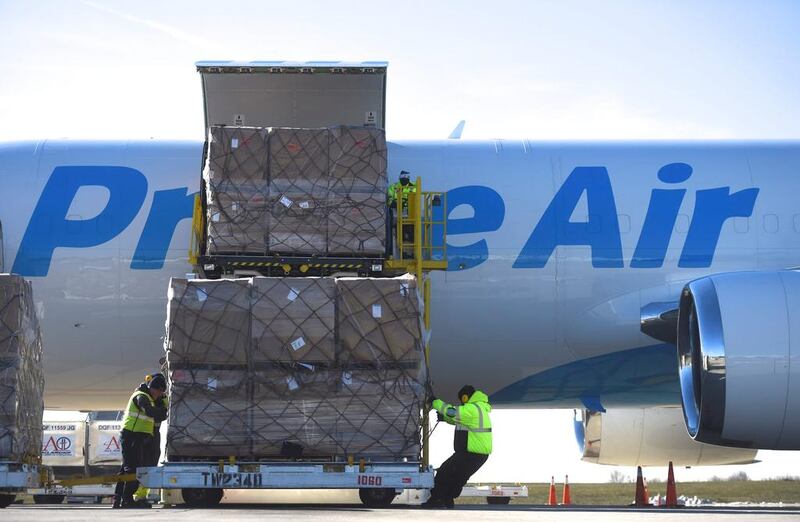A cargo plane emblazoned with Prime Air descended from an empty sky at Lehigh Valley International Airport last week, 90 minutes from the bustle of New York City, loaded with crates of goods during the peak holiday shopping season.
It is one of 40 jets leased by Amazon.com for a new cargo service to meet delivery demand from the retail major’s customers. Payload data and interviews with airport officials around the country show that Prime Air aircraft are flying nearly full but with lightweight loads, taking away valued business from FedEx and United Parcel Service.
Expanding into transport, from lorries to planes, is one of Amazon’s most important endeavours as it strives to lure new customers with fast shipping while keeping costs under control. The world’s largest online retailer is sending more packages, more often, and later in the day to serve its estimated 35 million to more than 50 million US members of Amazon Prime, a service that promises two-day shipping for US$99 a year.
Bulky boxes with goods once purchased in stores, such as toilet paper, are a revenue driver at UPS and FedEx. That is in part because they are now charging customers increasingly by boxes’ volume rather than weight. Shipping its own big, light packages is helping Amazon dodge these rising fees.
To date, Amazon has only said it leased the aircraft to speed up shipping and to backstop cargo partners during the holiday season. FedEx and UPS have delivered items late for Christmas in recent years. “Our own delivery efforts are needed to supplement that capacity rather than replace it,” said Kelly Cheeseman, an Amazon spokeswoman. She declined to comment on eluding cargo airline fees.
Amazon’s aircraft fly to more then 10 airports across the US, supplying its warehouses nearby. Officials at four airports said Amazon’s flights are operating near capacity but landing with lower-than-average weight, meaning it is placing low-density shipments inside the jets.
Amazon aircraft handled, monthly, only between 37 per cent and 52 per cent of their maximum loads by weight, according to an analysis of cargo, capacity and landing data from the four airports, with supplementary information from tracking website FlightAware.com. By contrast, FedEx and UPS were 53 per cent and 56 per cent capacity, respectively, according to US transportation department data for the year ending in September, excluding weight carried for free.
“You’re dealing with cargo that is big in dimensions but in pure weight it is light,” said an airport ramp manager in California.
Airports in Tampa and Charlotte reported similar payload data for the carriers contracted by Amazon but they did not specify whether the flights were full by volume or whether they were operated on Amazon’s behalf. A seventh airport outside Chicago said the aircraft were not full, although daily flights only started in October, and Amazon likely is learning the market, transport experts said. The remaining airports did not comment.
FedEx declined to comment but the company is spending billions to protect its cut of this growing pie. On Tuesday, FedEx reported a second-quarter profit that fell short of analysts’s forecasts amid an increase in operating expenses, as the company builds up its infrastructure. It said it will spend about US$5.6 billion on capital expenditures next year. It also said it had invested $1bn in aircraft and aircraft-related equipment in the first half of its current fiscal year, and would lay out another $600 million in the second half.
Steve Gaut, the vice president of public relations at UPS, declined to comment on Amazon’s airline but said customers commonly handle parts of their logistics in-house.
Reuters could not determine the extent to which, if any, Prime Air had an effect on the bottom lines of FedEx or UPS to date.
Reuters could also not determine how much Amazon has spent on aircraft leases so far, key to whether the fleet has cut its costs overall.
The payload figures do not include last month or this month, when contractor ABX Air, a unit of Air Transport Services Group, paused flights for Amazon after a pilot strike.
Flight data shows another way that Amazon is departing from cargo companies’ road map in an attempt to reach its top goal – rapid delivery.
Using FlightAware.com and similar websites, Reuters tracked the schedules of Amazon contractors and verified with airports which flights were on behalf of the retailer.
Many of the company’s eastbound flights leave the states of Washington and California unusually late at night – its flight from Stockton, California, to Wilmington, Ohio, departs close to 2am Pacific Time, for example. FedEx instead schedules most eastbound services no later than 9pm to ensure arrival at its Memphis, Tennessee, hub in time for sorting packages overnight.
The difference is that cargo airlines stop at airport hubs so they can fill aircraft easily with boxes from many origins. Amazon does this much less.
But flying without a stopover is faster, helping Amazon cut shipping times from Prime’s two-day standard, to a day or even hours. Scheduling later departures has an advantage, too.
“Most people have a tendency to order packages when they’re home” from work, said Brian Clancy, the managing director of advisory firm Logistics Capital and Strategy. Amazon is “waiting for the orders”.
Amazon also saves time by flying to remote locations such as Lehigh Valley, which are near cities and its warehouses but have little traffic. Expectations are for Amazon to stretch well beyond Lehigh Valley and the existing airports Prime Air serves.
“We’re just seeing the beginning of this,” said Marc Wulfraat, the president of logistics consultancy MWPVL International. “We could see Toronto. We could see Denver. They’re going to need a lot more planes,” he said.
* Reuters
business@thenational.ae
Follow The National's Business section on Twitter





